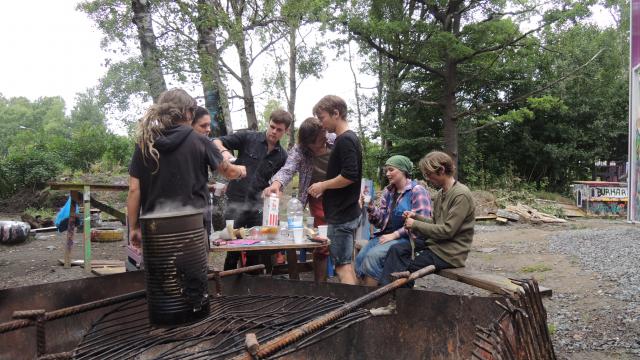
On November 29, 2008, an anti-fascist group planned to meet at Cyclopen, an alternative activist space in Stockholm. Fortuitously, the meeting was postponed: a firebomb exploded at the meeting's scheduled start time, burning Cyclopen to ashes.
“The Network Against Racism group was organizing against Salem, back then, the largest meeting of fascists in Scandinavia,” recounts Victor Marx, who is the architect coordinating the second, nearly finished Cyclopen. “But luckily the generator broke, so the meeting was postponed. The fascists wanted them to be inside when it exploded.”
The new Cyclopen will open on September 21, starting off with an opening party. By helping out with their preparations for a day, I witnessed the Swedish collective’s strength and resilience to build a space that is bigger and more versatile.
The new two-story building stands over five meters tall, with room to park a truck in the main hall. It was raised entirely by hundreds of activists who gave their time, without pay, over the last three summers. They applied consensus and a horizontal ethos right down to the architectural decisions.
“This space will be important for the district of Högdalen and the whole of Stockholm,” Ivar Mattinsson says while taking a break from fixing a roof cable ladder that supports audio and lighting in the building's main room. “There was a government funded local theater nearby. But like so many projects, the government has cut the funding and it’s now closed.
“Cyclopen will be an independent space for local groups, prioritizing far left and anarchist groups," he continued. "It can be used for meetings, events and conferences. The group Allt åt Alla [Everything for Everyone] has planned a convergence here, and local community and immigrant groups will also now have a space.”
In addition, the 450 square-meter space will house a community library, host cheap weekly meals, accommodate workshops and provide a place for cultural exchange.
Bright and bold, the building is encased in colorful translucent strips, which have fire retardant properties – the same material that goes into riot shields. “It has a strong shell like a turtle,” says Martinsson, who has been a member of Cyclopen since its squat beginnings over 10 years ago.
“Its design breaks the cliché of a normal punk house, which has encouraged more passing people to engage with the project. It’s light, transparent and inviting, rather than a fortress: in this way we have broken out of our bubble.”
Further, the building's color sharply contrasts with the gray 1960s concrete tower blocks common to its district of Högdalen. Martinsson tells me how the area faces similar issues as Stockholm's northern districts, which came to international attention due to riots earlier this year. Likewise, Högdalen is dealing with severe poverty, unemployment, racism and the destruction of common spaces.
“In Högdalen, like across the city, corporations are moving in and monopolizing commercial space and privatizing what was public, like community housing. People must buy IKEA homes, kitted out with IKEA furniture and [with] an IKEA loan from the bank. CityCon are one of the other big monopolies taking over," he adds.
"These venture capitalists are trying to gain legitimacy from local groups with small offers of money for an endorsement. So instead we offer a choice and a free space to use, so the groups are not forced to legitimize the gentrification process.”
In the summer of 2011, the activists building the new Cyclopen completed drainage and groundwork. Last year, the concrete foundations were set in just one week. A punk collective of welders from Hõrby in southern Sweden created a scaffolding system that forms the building's outer frame. The main structure of heavy wooden beams was hand-lifted, "the medieval way," using pulleys and through collective strength.
While I was on site, I met volunteer builders who were there for the first time, alongside others that were devoting extended periods to see the project through.
The main electrician, Angelica Seger, was a full-time paid electrician for four years before she took a break, planning to travel and work on Cyclopen. But instead of traveling, she decided to devote all her time to the building. “When I decided to put six months into the project I was so happy, because of this collective of people," she says. "They are rare, trying to create a more social humane society.”
“People giving their time for free is one of the cornerstones," she continues, comparing Cyclopen to traditional building sites, "and that everyone is equal in decision-making is also key. On site, anyone that comes can choose what work they will do, and it is less time pressured and [more] cooperative, more relaxed even though people work really hard.”
"It’s a building made by people, citizens, rather than made for consumers. In Stockholm there is almost nothing like it.”
Many of the voluntary workers are learning new building skills, and gaining appreciation of an environment with dangers – not least, the spaces where a person can fall up to five meters straight onto a concrete floor. Architect Victor Marx says they have not had accidents. "Because we don’t have all the precautions – sometimes as they’re too expensive, like cranes – people use their common sense.”
Although Marx has overall coordination responsibilities, the design and implementation of the building has happened through a horizontal, participatory process using consensus. Working groups focus on creating proposals with decisions passed through group meetings, including the building’s design and layout. Once the collective received the funds and insurance money, the group faced the challenge of people who joining the meetings to disrupt them.
But from a long-term perspective, dealing with adversity and becoming stronger in the face of difficulties is woven into the Cylcopen experience. The collective, originally composed of squatters, would hold a building for a few weeks before authorities forcibly removed them. Sweden is one of the hardest places to squat in Europe.
Cyclopen member Dane Trankell, who had been squatting since the 1980s, describes how the movement changed course with the changing times.
“Neoliberalism has eaten up most of the areas you can squat, and we got tired of this masculine confrontational strategy – [authorities] had such a monopoly on violence and we were always portrayed as ‘terrorists’.
“Now we are legitimate," he says. "We’re going down the line of the ‘friendly struggle,’ so we create our own commons and our own alternatives.”
For more details on Cyclopen, visit www.cyklopen.se
3 WAYS TO SHOW YOUR SUPPORT
- Log in to post comments

















